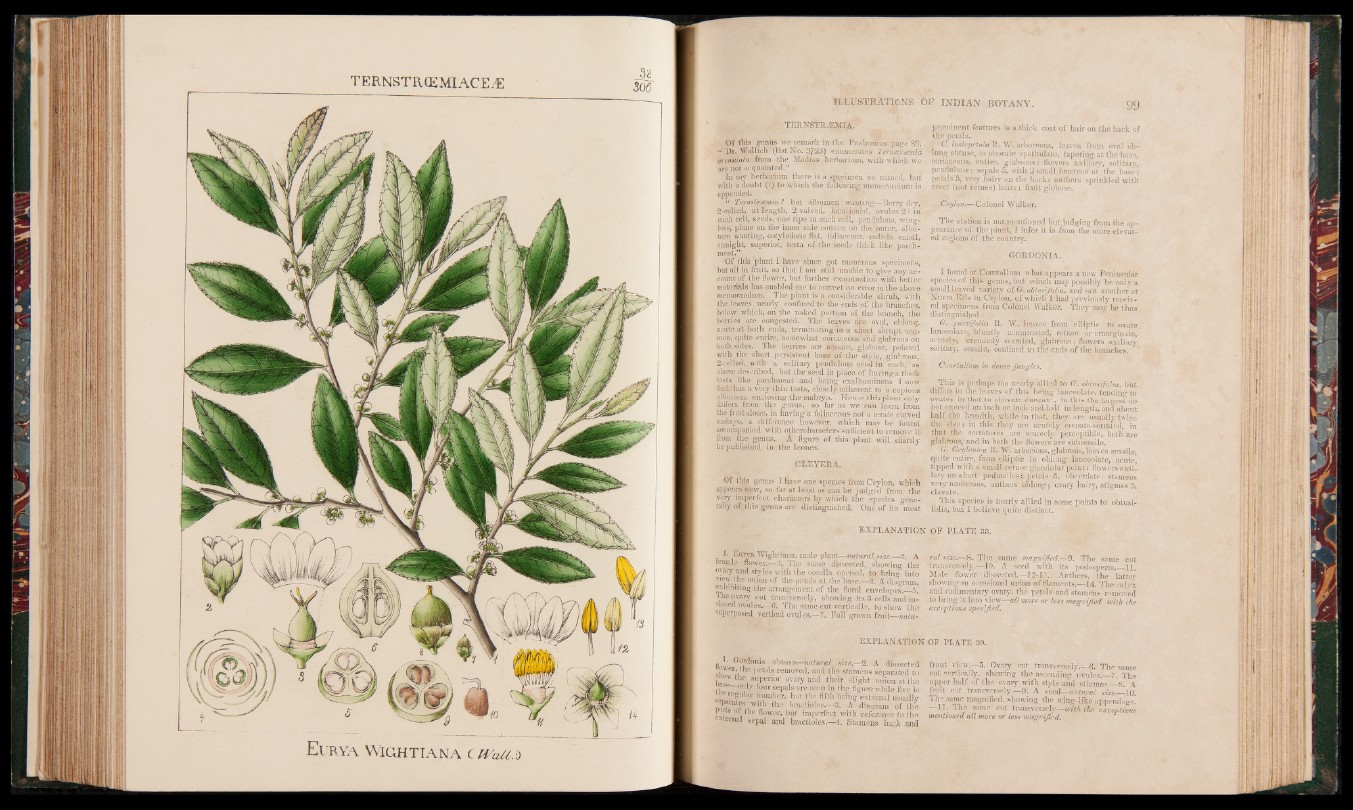
TERNSTRCEMIACEA!
: 1 TERNSTIUEMIA.
Of this genus we remark in the Prodromus page 86,
u Dr. Wallich (list No. 3723) enumerates Ternstraimia
crenuluta- from the Madras herbarium, with which we
are not acquainted.”
In my herbarium there is a specimen so named, but
with a doubt (f|^to which the following memorandum is
appended,
“ Ternstreemia ? but albumen wanting—Berry dry, ■ I
2-celled, at length, 2 valved, loculicidal, ovules 2? in
each cell, seeds, one ripe in each cell, pendulous, wing- 1
less, plane on the inner side convex on the duter, salbu-
men wanting, cotyledons flat, fqliaceous, radicle small,
straight, superior, testa of the seeds thick like parchment,”
Of this -plant I have since got numerous specimens^
but all in fruit, so that I am still unable to give any account
of the flower, but further examination with better
materials has enabled me to correct an error in the above
memorandum. The plant is a considerable, shrub, with
the leaves nearly confined to the ends of the branches,
below which, on the naked portion of the branch, the
berries are congested. The leaves are oval, oblong,
acute at both ends, terminating in a short abrupt aeii-
men, quite entire, somewhat coriaceous “and glabrous on
both sides. The berries are sessile, globose, pointed
with the short persistent base of the kyle, glabrous,. l
2-celled, with a solitary pendulous seed in each, as
above described, but the seed in place of having a thick
testa like parchment and being exalbuminous I now
find-has a very thin testa, closely adherent to a copious
albumen, enclosing the embryo. Hence this plant only
differs from the genus, so far as we can learn from
the fruit alone, in having a foliaceous notVterate curved
embryo, a difference however, which may be found
accompanied with othercharacters sufficient to remove it
from the genus,. A figure of this plant will shortly
be published in the leones.
GLEYERA.
Of this genus I have one species from Ceylon, which
appears-'mew, so dar at least as can be judged from the
very imperfect characters by which tne species generally
of this genus are distinguished. One of its 'most
explanation
1. Eurya Wightiana, male plant—natural size.—2. A
female flower.—3. The same dissected, showing the
ovary and styles with the corolla opened, to bring into
V1Cvk—6 ulxion of JR petals at the base.—4. A diagram,
exhibiting the arrangement of the floral envelopes.—5.
I he ovary cut transversely, showing its 3 cells, and inclosed
ovules.—*>. The same cut vertically, to show the
superposed vertical ovules.— 7. Full'grown fruit—natuprominent
features is a thick coat of hair on the back of
the petals.
- 0. lasiopetala R. W.arboreous, leaves from oval oblong
obtuse, to obovate spathulate, tapering at the base,
coriaceous, entire, glabrous; flowers axillary, solitary,
pendulous; sepals 5, with 2 small bracteas at the base;
petals 5, very hairy on the back: anthers sprinkled with
erect (hot fëtuse) hairs: fruit globose.
. .Ceylon.—Colonel Walker.
The station is not mentioned but judging from the appearance
of the plant, I infer it is from the more elevated
regions o f the country.
GORDONIA.
I found ht pourtallum what appears a new Peninsular
species of this genus, but which may possibly be only a
small leaved variety of G. obiusifolia, and saw another at
Nuera Ejla in G'.eylon, of which I had previously received
specimens from Colonel Walker. They may be thus
distinguished <
G. .parvifolia R. W. leaves from elliptic to ovate
lanceolate, bluntly acuminated, retuse or emarginate,
acutely, crenately serrated, glabrous $ flowers axillary
solitary, sessile, confined to thé ends of the branches.
Courtallum in dense jungles. ■<"$
This is perhaps too nearly allied to G.[obiusifolia, but
differs in the leaves of this being lanceolate, tending to
ovate ;' in that to obovate =cuneate; in this the largest do
not exceed an inch qyinch and half in length, and about
half the breadth, whilè in that, they - are usually twice
the size -. in this they are acutely crenato-serrated, in
that the serratures. are scarcely perceptible, both are
glabrous, and in both the flowers are subsessile.
G. Ceylanica R. W ;. arborious, glabrous, leaves sessile,
quite entire, from elliptic to oblong lanceolate, acute,
tipped with a small retuse glandular point: flowers axillary
on short peduncles | petals -5, obcOrdate: stamens
very numerous, anthers oblong; ovaiy hairy, stigmas 5,
■ clavate.
This species is nearly allied in some points to obtusi-
folia, but I believe quite distinct. .
OF PLATE 33.
ral size.—8. The same magnified.—& The same cut
transversely.—10. A seed with its. podosperm.—11.
Male flower dissected.— 12-13. Anthers, the latter
showing an occasional union of filaments.—14. The calyx
and rudimentary ovaiy, the petals and stamens removed
to bring it into view—all more or less magnified with ike
exceptions specified.
EXPLANATION OF PLATE 39.
- ^ h e petals removed, and the stamens separated t
i PI s,JPerior ovaty and their slight union at th
«dse—°nly four sepals are-seen in the, figure while five i
uieiegular number, but the fifth being external usualb
S f c S l l the ^raki°les.—3. A diagram of tin
gflSUE • f flower’ i l l imperfect with reference to th<
nial sepal and bractioles.—4. Stamens back ant
front view.—5. Ovaiy cut transversely.—6 / The same
cut vertically, shoving the ascending ovules.__7. The
upper half of the ovary with style and stigmas.— 8. A
fruit cut transversely.--^. A seed—natural size.— 10.
The same magnified, showing the wing-like appendage.
—11. The same cut transversely--«,*//* the exceptions
mentioned all more or less magnified.